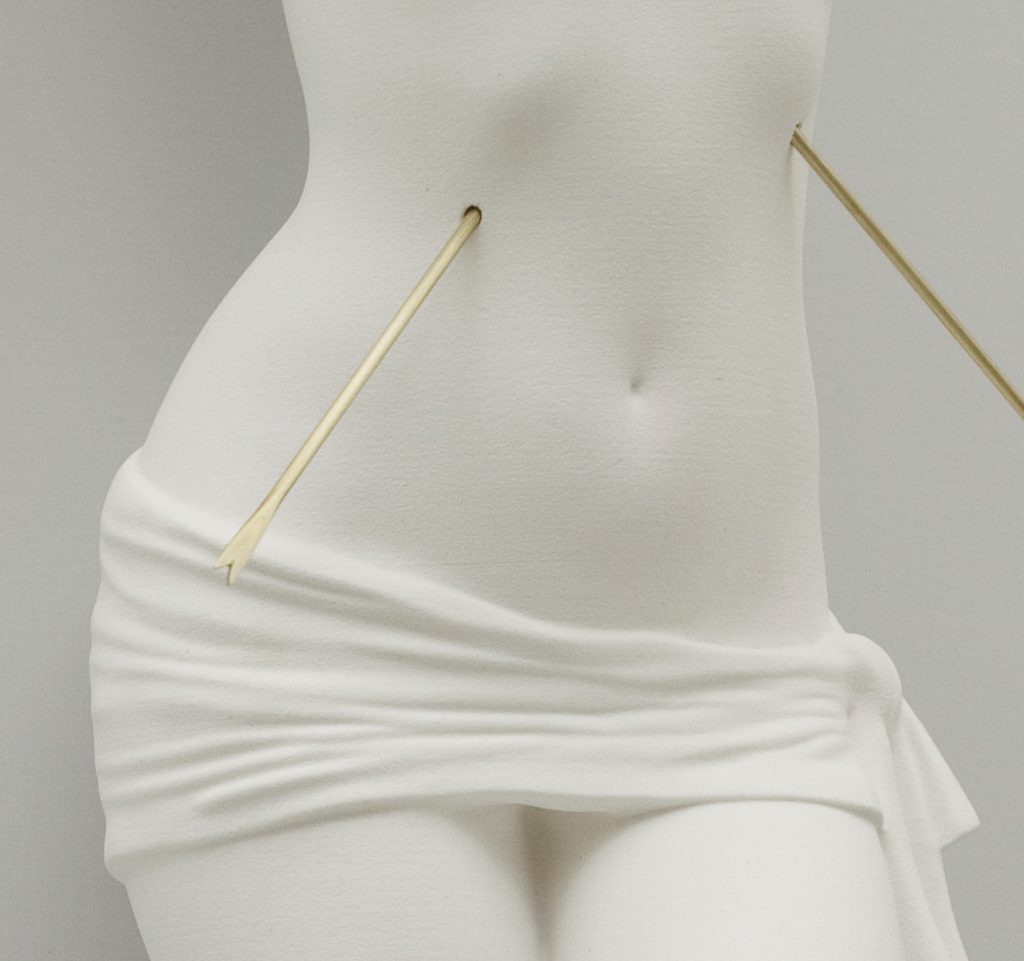Martyr, 2019, porcelain plaster, brass, 58 x 20 x 20 cm, photo © Aurora Reinhard
The sculpture was created with the aid of 3d scanning and printing technique. The final work is a porcelain plaster cast of the print. In order to give a hint of the production technique the 3d-printing texture is visible in the final work.

Among Aurora Reinhard’s latest works is Martyr (2018) – a white plaster sculpture, nearly a half-metre high, of a naked woman whose body is pierced by three golden arrows. The work is a kind of self-portrait: it is based on a 3D scan of the artist’s own body, and the arrows refer to romantic encounters that have touched her deeply.
Reinhard seeks the subjects for her works in media and advertising imagery, and in the history of western art. She, nevertheless, interprets the images she finds through her own personal experiences, frequently switching the gender or direction of a gaze. The background to this work is the figure of Saint Sebastian, familiar from Renaissance art: an officer in the Roman army and a Christian, he lived in the 3rd century AD and miraculously survived his “martyrdom” and, judging by some of the paintings of him, does not even appear to have suffered very much.
By replacing the male saint with her own body, Reinhard brings this almost two millennia-year-old-story into the present. She gives it not only a personal, but also a universally comprehensible significance, associated not with divine relations but with those between human beings. She has been called a “life explorer” and the power of emotional relationships between women and men has long been a topic of her art. Conversely, she has also dealt – often very directly – with various issues involved in the pictorial representation of sexuality and gender identity. In so doing she has also put herself on the line, seeking answers both in front of the camera and behind it. Either disguised or, as in her recent works, without a mask, she herself is the model for her own works.
Recurrent themes include an almost systematic and frequently provocative critique of one dimensional, idealized images of women. The female figures in her photographic works wear excessive amounts of make up and dress in a manner that evokes the imagery of pornography. This exaggeration is, nevertheless, so obvious and her means of constructing these illusions so transparent that the works’ real message cannot go unrecognized.
One thing that it is impossible to ignore when faced with Reinhard’s photographs and sculptures is how perfect they are. It is as though they are self generated or have fallen from heaven, even when they are cracked, as in her plaster sculpture Broken (2017). Such works are reminiscent of (and also occasionally imitate) industrially manufactured luxury products. And yet the immaculateness of Reinhard’s works is not an end in itself. It is overdone and serves the same goal as the excessive make-up and costumes in her photographs. She exposes the mind’s covert hopes and desires while, at the same time, revealing the mirage-like character of the impulses that fuel them.
Timo Valjakka, Translation Mike Garner
